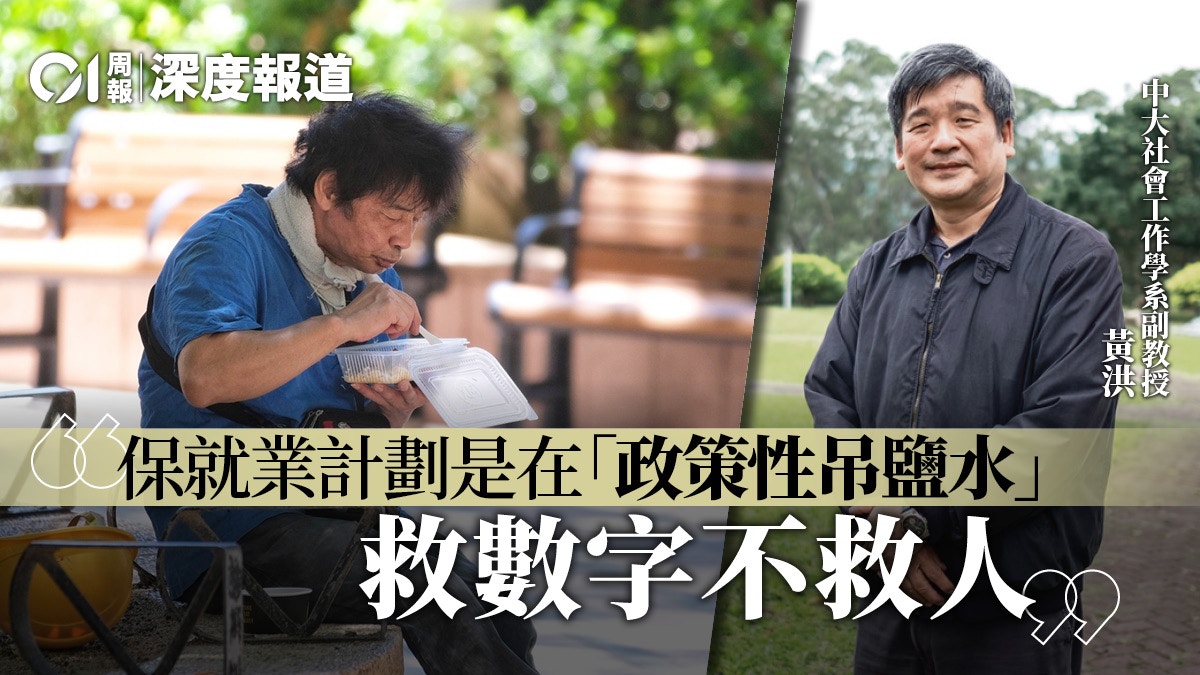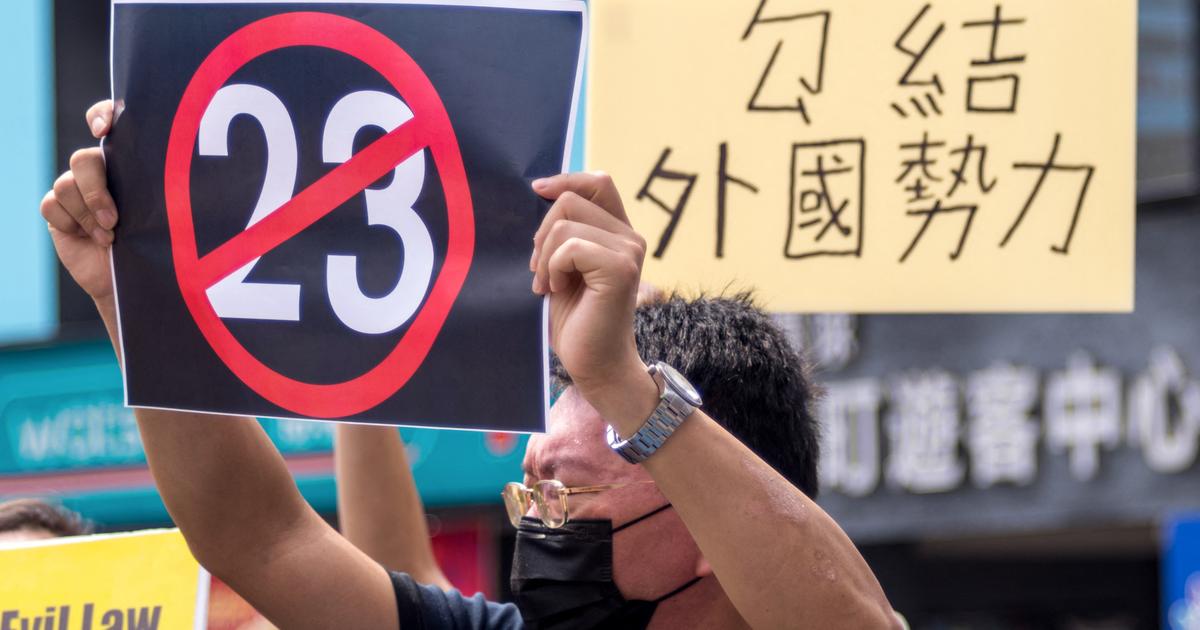weekly
Written by: Cheng Xue
2020-12-10 16:00
Last update date: 2020-12-10 16:00
The latest data released by the Census and Statistics Department in the middle of last month showed that the seasonally adjusted unemployment rate remained at 6.4% from August to October, and the underemployment rate remained at 3.8%.
The figures have not changed. Can it show that the Hong Kong government has effectively alleviated the unemployment problem?
Now that the fourth wave of the epidemic hits, Huang Hong, an associate professor of the Department of Social Work at the Chinese University of Hong Kong, estimates that the unemployment rate may continue to rise, exceeding 7%.
How to alleviate the plight of the unemployed and their families has become an urgent issue before the Hong Kong Government.
In this regard, "Hong Kong 01" had a dialogue with Professor Huang Hong to discuss how to understand the current unemployment rate and underemployment rate, and what crisis Hong Kong labor market is facing.
Huang Hong believes that Hong Kong’s labor market cannot be analysed solely through ratios, but a comprehensive analysis of unemployment and underemployment through specific changes in figures.
He pointed out that a new hidden danger that is emerging in Hong Kong is the decline in the labor force, with middle-aged young people as the main force, which may lead to an increase in the dependency ratio.
In addition, Huang Hong criticized the government for paying too much attention to the ratio and ignoring that there are vivid people behind the numbers.
"We should pay attention to these people behind the numbers: how many people are there? What kind of living conditions are they in? What are the problems facing the labor market?"
Hong Kong 01: According to the latest data from the Census and Statistics Department, the current unemployment rate and underemployment rate in Hong Kong remain at 6.4% and 3.8% respectively (Figure 1). What kind of problems do these figures reflect in the current labor market in Hong Kong?
Huang Hong pointed out that the unemployment rate or underemployment rate cannot be looked at solely.
Looking at the labor market, we should pay attention to three figures: the labor force, the unemployed and the underemployed.
(Hong Kong 01 drawing)
Huang Hong:
We cannot look solely at the unemployment rate or underemployment rate.
Looking at the labor market, we should pay attention to three figures: the labor force, the unemployed and the underemployed.
Analyze as a whole, not individually.
In addition, the focus of analyzing the figures is not to look at the proportions. It is more important to understand the actual figures: how many laborers, how many unemployed, and underemployed people.
The current statistics in Hong Kong are more complicated because they are calculated using a three-month average.
However, the changes in various aspects including the epidemic situation have been rapid in recent months, and each month is a little different. If you look at the three-month average, it is very confusing and lagging.
Hong Kong 01: How should we read these figures, and what problems are reflected behind the figures?
Hidden dangers in the job market, the young labor force is significantly decreasing
Huang Hong:
Regardless of whether you look at the unemployment rate or the underemployment rate, its denominator is the labor population, that is, the labor population is divided by the unemployed or underemployed to calculate a ratio.
Then, when the working population has changed a lot, it is a problem to look at the ratio.
The core issue I saw this time is that the working population has been decreasing since last year.
From the data, we can see that the statistics from July to September this year show that Hong Kong has a labor force of 3,884,600, a decrease of more than 4,000 from the 3,888,800 from June to August.
This is a three-month increase or decrease (Figure 2).
Huang Hong pointed out that the most important change at the moment is the decrease in the overall workforce in Hong Kong.
(Hong Kong 01 drawing)
If we look at the changes in one month, the labor force increased by 12,600 and 20,900 in May and June, which is reasonable.
Because it was the summer vacation and many middle school and university graduates entered the labor market, the labor force should increase in June, July, and August.
However, the labor force decreased by 9,100 and 13,500 in August and September, which is unreasonable.
The decrease in the overall labor force in 2019 may be due to the decrease in Hong Kong-born population and therefore the decrease in school-age graduates, which has affected the labor market.
Even so, compared with last year, the percentage reduction is probably 0.1% to 0.2%, which is less than 1%.
Until December 2019, it began to exceed 1%.
Over the past few months, the labor force has fallen by about 2% every three months.
So, how many people have actually been reduced?
From January to September 2020, the labor force sometimes decreased rapidly and sometimes slowed down, and the labor force even increased in May and June.
So why did the labor force decrease from November and December last year?
It may be related to social events.
The labor population dropped significantly in January, which should be related to the epidemic.
Hong Kong 01: Generally speaking, what causes the labor force to decrease? Why does this happen?
Huang Hong:
Why has the population increase in the labor market slowed down or decreased?
One is the decrease in the graduated population of school age, and the other is that some people choose to leave the labor market.
There may be three reasons for leaving the labor market.
One is to retire early. An adult in his 50s and 60s didn't have to retire, but because it was difficult to find a job, he didn't look for a job and chose to retire early.
There is an academic term for such a group of people called "discourage worker" (discourage worker).
Under the government's definition, not looking for a job is not unemployed, but leaving the labor market.
The second situation is immigration.
Since the beginning of this year, everyone has heard a lot of core age-middle-aged people in their 30s who choose to emigrate and leave Hong Kong's labor market.
In the third situation, I think there may be a possibility: employers do not want to hire young people, and young people do not want to work and do not enter the labor market.
Why did nearly 10,000 people leave the labor market last year?
To verify our conjecture, we must look at the age and gender distribution of these people who have left.
The overall working population has decreased, with young and middle-aged as the main groups, while the elderly working population has increased.
(Hong Kong 01 drawing)
Looking at the relevant data, we can see that in the second quarter of this year, the combined labor force of men and women aged 20 to 24 fell from 214,600 in the first quarter to 196,100, a decrease of 18,500.
The strange thing is that the second season is the graduation season from April to June. How can it be reduced rather than increased?
Why is there so much less labor force between 20 and 24 years old?
Is it emigrating or studying abroad?
Of course there is such a possibility, but are there so many?
Looking at 55 to 59 years old, the labor force in the second quarter increased by more than a thousand people compared with the first quarter; 60 to 64 years old increased faster, with more than 10,000 people; 65 years old and older were also increasing, and it was close to the highest level in history. The working population reached 157,300.
Through these two sets of figures, it is found that the assumption of early retirement does not hold.
The older working population has been declining in the past, but now it is on the contrary and is beginning to rise.
This change began to occur after social events and the epidemic last year.
The situation of the middle-aged working population has also dropped significantly.
The number of people aged 40 to 44 decreased by 6,900 in the second quarter, and the number of people aged 45 to 49 decreased by 2,800.
Where did these middle-aged people go?
They may retire early, or they may not find a job, have been unemployed for a long time, and choose to emigrate to leave the labor market.
But the problem is that it stands to reason that these people have to support their families and live on their own, and they should be among the unemployed—that is, even if they cannot find a job, they should not leave the labor market.
So, nearly 9,700 people in the 40-49 age group have left the labor market, which is very unreasonable.
It can be seen from the data that the labor market population is declining. If it is divided by age group, young people are the main ones, followed by middle-aged people, while the working population of the elderly over 60 years old has increased.
In addition, there are the unemployed and underemployed, and we have to use age group analysis methods to understand.
Back to the first question.
In fact, starting from January this year, the labor force has declined rapidly, with a drop of two percentage points almost every three months, which is already very exaggerated.
When the denominator changes greatly, looking at the unemployment and underemployment situation, it is actually more serious and the number of people is even larger.
Hong Kong 01: Should we pay more attention to the actual figures than the unemployment rate and underemployment rate?
Huang Hong:
Since January, the number of unemployed people has increased by 13,700, 16,300, and 12,200 every month.
It can be seen that after the outbreak of the epidemic, the number of unemployed people has risen rapidly, with tens of thousands of people unemployed every month.
Correspondingly, the unemployment rate is also rising rapidly.
From April to June, the number of unemployed people declined in terms of monthly increase and decrease. Although the seasonal unemployment rate was slowly rising, the increase rate decreased significantly, and it basically stopped rising after June.
But as mentioned earlier, the decline in the unemployment rate is also due to the decrease in the denominator.
Looking at the unemployed population, 230,000, 241,000, 242,500, and 248,300 are actually increasing by 10,000 to 10,000.
Although the unemployment rate is stable, the overall number of people has risen rapidly.
Hong Kong 01: Both the number of unemployed and underemployed have risen sharply, and Hong Kong's labor market is clearly undergoing tremendous changes. In your opinion, what caused it? What are the problems reflected by the changes in numbers?
Huang Hong:
I think the first is because of the epidemic, and the second is related to underemployment.
Generally speaking, the relationship between underemployment and unemployment is like this: you first become unemployed, and if you cannot find a full-time job, you can go to a part-time job, or you can lower your wages, thus becoming underemployment.
Another more likely situation is underemployment first.
In the manufacturing industry, there is a word called "hanging salt water." If you give it to you, you will not die immediately.
In other words, keep workers' positions instead of dismissing them immediately, and then invite these workers back when the economy recovers.
Huang Hong's analysis believes that the employment protection plan is actually a "policy suspension", which can prevent the unemployment rate from rising too fast, but it cannot fundamentally protect labor rights.
(Photo by Lu Yiming)
What is currently emerging in Hong Kong is a "policy-based suspension of salt water", which is the so-called employment protection plan of the government.
"Ensure employment" is actually a few people to keep the workers' jobs, but do workers need to return to work?
Without protection, you may even be forced to take a lot of unpaid leave.
Therefore, under the government's employment protection policy, we have seen the number of underemployed people rise sharply, starting in January and increasing by tens of thousands every month, indicating that there was not enough work to start.
This is obviously affected by the epidemic.
The number declined from April to June, when the number of underemployment was similar to the trend of unemployment-this is the effect of the epidemic.
But beginning in September, the number of underemployment was falling, while the number of unemployment was rising.
This new situation is more worrying: this part of the population may have changed from underemployment to unemployment.
The decrease in the number of employers applying for the second employment guarantee scheme may be because they feel that even with government subsidies, it is difficult to sustain them, and they are preparing to fire their employees.
We should also note that the working population also decreased by more than 10,000 in September, but the unemployed population increased by more than 5,000.
The group of people who disappeared in the middle may have chosen to withdraw from the labor market, emigrate, or study because of lack of employment.
What is worrying is that the reduction of the working population may become a normal state, which deserves our attention.
At present, the government and the media are more concerned about the unemployment rate and underemployment rate. In fact, we should pay attention to the people behind the figures after making an overall analysis: how many people are there?
What is your living situation?
What are the problems facing the labor market?
The above is excerpted from the 243th "Hong Kong 01" Weekly Report (December 7, 2020) "Interview with Huang Hong, Associate Professor of the Department of Social Engineering, Chinese University of China, Reflecting the Decline of the Labor Population". Please
click here to
sample the weekly newsletter for more in-depth reports.
Selected content of the 243 issue of "Hong Kong 01" Weekly News:
[Cover report] Learning from Biden to reflect on Hong Kong’s capitalist progress to the "bottom"
Biden announces economic team, labor returns to policy focus
Unemployment is coming back, and the CSSA policy is difficult to respond to social demands
The refusal to amend the "Prevention of Bribery Ordinance" will allow the Chief Executive to continue "no kingly control"?
Procurement of new crown vaccine slows 100,000 beats, Hong Kong's anti-epidemic falls into parallel time
A matching picture triggers a public opinion war between China and Australia. China has a "dual standard" that it must carry
Lack of attention to protect underemployed people
"Bring Budapest to Warsaw" Poland and Hungary challenge the European integration model
Why did a Tibetan boy lead a city by himself to Japan and South Korea?
Labor Security Labor Insurance Employment Program In-depth report on unemployment rate 01 Weekly Employment


/cloudfront-eu-central-1.images.arcpublishing.com/prisa/3I74UEXLYRBBRPGPSGWNN6WXH4.jpg)



